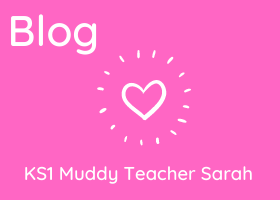Outdoor Learning safety in Primary Schools
We take safety very seriously at The Muddy Puddle Teacher and outdoor learning does come with some very different risks to those that are indoors.
However, we are not Forest School and we do not promote the use of fire or tools. Furthermore, we suggest you work within your own grounds. Those that you are familiar with and already have comprehensive risk assessments and health and safety checks.
We feel this reduces the workload for our teachers but also it makes sense! You have that well-prepared space so use it!
We do however use resources you may not normally use such as sticks, rocks, mud, leaves and touch trees, plants and vegetables.
Here are some of our Muddy Top Tips that are embedded in all of our training packages if you want to be sure this area is well covered. The Outdoor Learning Training will take you through policies, handbooks and risk assessments and safety games to do with the children.
We also have to remember that when we start to teach the children how to use natural resources there going to want to do this out of your setting. That is why outdoor learning is so powerful, the learning can be continued and remembered every time the child is taken outside! So the work below is vital that you follow it, repeat it and remind children of it. Even send it out to parents and carers too!
Using natural resources
Check your spaces. We know this is hard to do but it does need to be done. You may be very fortunate and have a very private space. But for most of us, litter is often thrown into play spaces over-night and cats are regular visitors! So a quick once over will eliminate these risks. This needs to be considered or policies put in place for.
Risk assessing with the children. Every time you go outside with the children make it good practice that you risk assess the space. Check the floor for any unknown materials and to call an adult over. What is the weather like? How do we need to best manage it? If it’s cold we need to move more, check for slippy surfaces. If it’s hot we need to locate shade. If it is rainy, how can we get shelter what are other surfaces like?
Feet first then hands. A great way of avoiding the above risk. Even after a thorough check sometimes things on the floor cannot always be seen. So, get all of the children in the habit of saying ‘feet first then hands’. Remind children that there could be things on the floor that are not safe for our hands, so it is best to check with our hard boots and shoes first what’s on the floor. There could be something sharp and we would see this glisten at us if there was and we could then call over an adult. Remind the children to never pick it up themselves.
Using sticks. Many children will not know how to use safely and go for very large sticks or very long sticks that could be dangerous. So, we have a little rhyme to help! ‘Sticks stay low they tickle our toe, if they go high, they poke us in the eye!’ Keep saying this rhyme correcting and reminding them of it. We always put our thumbs on the top of the stick and drag it to prevent a strained arm. If you are doing some imaginary play where sticks need to be high, talk to the children about how safely you will do this and constantly monitor. Remember it’s about making sure they’re safe when out of our care as well as the lesson you are teaching!
Using rocks. Rocks are incredibly useful if you use them safely. They’re perfect for rainy and windy days. So, set up the safety and there uses can be enjoyed. We teach rock safety through a game we call ‘rock babies. We ask the children to pick the rock up gently and to cradle it with two arms like a baby, this way it will not fall on their feet. We go for a walk then we place the baby down. We would not throw a baby so do not throw the rock! Place it down carefully and this irradiated any trapped fingers. The size is entirely up to your setting, but we never normally go over the palm of a child. If your class cannot be trusted with rocks, work with bean bags then small pebbles.
Using leaves. Because we work in our normal settings your health and safety reports should have assessed that the plants in your school are safe for children to be around. But do not take this for granted. Use the app ‘inaturalist’ and check what names they are and if it is safe for you to use the leaves. We use lots of leaves to write on for instance when learning to spell, multiplications that kind of thing.
Washing hands. We want children to get muddy, touch mud and get messy and not to worry about it. But we do need to remind children that animals are about at night and they do have harmful germs, so we do need to give our hands a good scrub after! No fingers in the mouths while we are outside learning.
Clothing. Make sure the children are appropriately dressed otherwise do not take them out. More harm than good will be done. We want children to enjoy going outside and to do this we need to give them comfortable memorable experiences.
Informing Parents. Do make sure that parents are notified about the activities you are doing, what the benefits are and what you need from then to help achieve this.
Ensure that your policies, handbooks and risk assessments are up to date and available on your website and parents are aware of this. In particular, make sure ‘The use of natural resources’ is on there.
Like our Muddy ideas?
Spread the word and check out our ideas in action on our YouTube channel!
Follow on Twitter @MuddyTeachers
Chat with others on our Facebook Group Muddy Puddle Group
Follow our Facebook Page to see newly launched products The Muddy Puddle Teacher
Get tips and Ideas on Instagram @the_muddy_puddle_teacher
The Muddy Puddle Teacher ®
Here are 3 top outdoor learning ideas to get you started :
- Make sure the children have the right clothing – bring a muddy bag in or dress for mud that day!
- Make it messy and muddy – why not you are outside!
- Stick to natural resources – less clearing up for you and more kind to the environment.
Our muddy resources support all curriculums and we use only natural resources so any school, anywhere can use our approach. Including Early Years Framework, NC, CfE, American Curriculums.
Looking for a group subscription? We offer big reductions for schools and nurseries that book in groups. The more staff the more the discount per person. Click here for a quote.
Outdoor learning in primary schools is an essential way to bring wellbeing to the classroom.
Here are some muddy top tips to make a start in each key stage.
- Outdoor Learning KS2 – Try taking 10-minute slots or brain breaks in between sessions. Do the Muddy Walk and Talk and just use it for general discussion or chat.
- Outdoor Learning KS1 – Try taking phonics games outside. Choose a sound and use leaves
- Outdoor Learning EYFS – If you can make sure there is an outside space that is accessible and start to reduce the plastic and have more natural objects. Such as leaves they can write on, stones to do art with. Strip back the made plastic objects and keep natural for optimum imagination and creative skills to be used.
- Outdoor Learning KS2 – Try taking 10-minute slots or brain breaks in between sessions. Do the Muddy Walk and Talk and just use it for general discussion or chat.
- Outdoor Learning KS1 – Try taking phonics games outside. Choose a sound and use leaves
- Outdoor Learning EYFS – If you can make sure there is an outside space that is accessible and start to reduce the plastic and have more natural objects. Such as leaves they can write on, stones to do art with. Strip back the made plastic objects and keep natural for optimum imagination and creative skills to be used.
For more outdoor learning ideas for primary schools, sign up for FREE! If it is active learning you are looking for try GoNoodle a great way to get kids moving inside the class.
Watch the MPT safety videos to help you practice the best outdoor learning methods. These videos are also useful for those practising forest school.
Search for more outdoor learning resources : Babies (0-2) | Tots (2-4) | EYFS (4-5) | KS1(5-7) | LKS2( 7-9) | UKS2 (9-11) | Special Needs
For Training head to: Accredited Training | Short Certificate Courses
Have you also checked: Outdoor Ebooks | Assembly Packs | Home Learning Packs | Safety Support | Special Outdoor Events
- Support Outdoor Learning charities and head to Learning through Landscapes who can help with free outdoor learning ideas.
- Institute for Outdoor Learning are also a fabulous charity to refer to if you want to gather ideas for outdoor learning training and organisations.
- Look out for Green Flag Award to promote outdoor learning in primary schools through the muddy puddles approach.
The new way to do Outdoor Learning
Teacher Training | Teaching Resources
EYFS | KS1 | KS2

